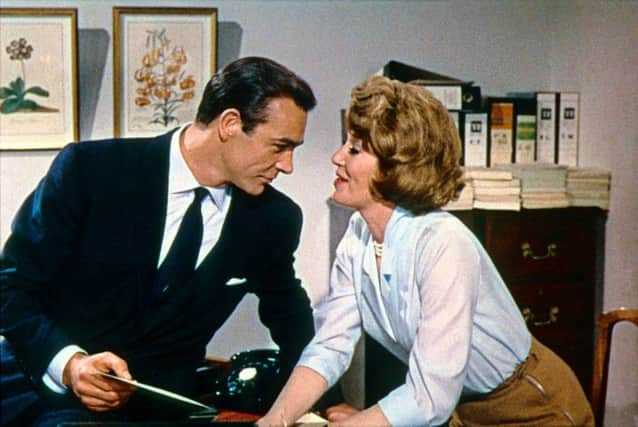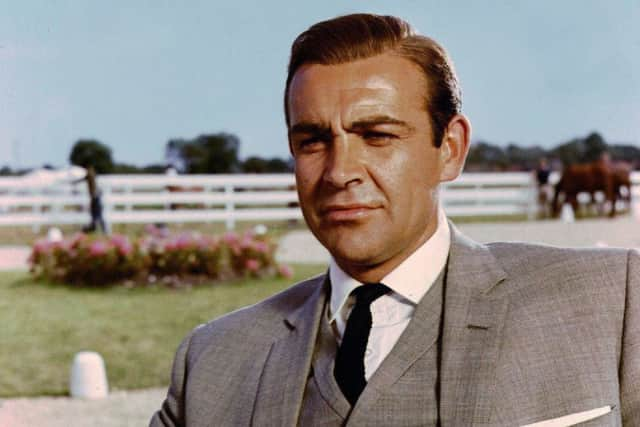Martyn McLaughlin: Star Sean Connery undimmed by age


THERE comes a time in every young man’s life when, even if he shares the inside leg measurement of a Cavalier King Charles Spaniel, he aspires to dress like Sean Connery. The memories of my first suit are doubtless sharper than its cut, but for the past 15 years they have been fondly held. Recently turned 21, I was running with a crowd that shunned the fashions of the day. All of us were stumbling awkwardly out of adolescence and hoped the journey to manhood would be made easier by aping a handful of icons whose way of carrying themselves hinted at its deep and inexplicable secrets.
The timeless classicism of Cary Grant was popular for a while if tricky to pull off in practice without resembling a member of the National Youth Assembly; Dean Martin’s imported Italian panache had us making onerous demands of a local tailor accustomed to churning out tin flutes fit for the dock of the local sheriff court. The result was invariably and predictably cataclysmic, bestowing peely wally lads from Inverclyde with a fleeting resemblance to undernourished clerks in the stockroom of a downmarket Genoa shoe shop. Those of who took the sartorial lark seriously soon learned to take the train up to Glasgow and to Slaters Menswear, the Howard Street emporium that has nipped and tucked many a young buck.
Advertisement
Hide AdAdvertisement
Hide AdIt was on the second floor of Slaters that I first saw the ensemble, a silvery three-piece vision that seemed to coo from its hanger. It was the epitome of urbanity, elegance and poise. More importantly, it almost exactly resembled the masterful glen check suit Big Sean wore in Goldfinger, right down to the minutiae (four buttons on the cuffs, soft shoulders on the jacket and, for full dapper points, a ticket pocket). It was my licence to kill for a mere £159.99, with free alterations to take the thighs in.


Looking back at old family photographs the other week, I came across the suit again and realised how the mind plays the cruellest of tricks. Rather than a secret agent, my fleshy, goofy younger self resembled a partially defrosted sausage swathed in duct tape. It was not the fault of the suit – a decent imitation sturdy enough to last through a few funerals and a graduation – but the way I held myself. I couldn’t move like Connery. No-one could.
The supergiant of Scotland’s modest firmament of bona fide film stars today turns 85, a grand birthday that has elicited a flurry of warm tributes. William McIlvanney and Ken Stott were among those to take part in an affectionate BBC Scotland retrospective which glided over the touchstones that dominate any appraisal of Connery: the early years in Fountainbridge; the James Bond movies; the undeviating accent. There will be other paeans, but few will focus on the physicality that gave him the same beguiling and enduring screen presence shared by a slender body of actors that includes James Cagney and Gary Cooper.
The clothes were a part of it, not least the resplendent threads provided by Anthony Sinclair, the Mayfair tailor to whom Connery was introduced by Terence Young, his director in Dr No, From Russia With Love and Thunderball. At a time when most men favoured boxy, double breasted suits, Sinclair – whose clientèle in the early 1960s was based around a core of senior Army officers – provided the Scot with garments boasting the free-moving, hourglass style of his trademark Conduit Cut.
From the turned-back silk cuff on his tuxedo jacket in Dr No to the navy suit with blue chalk stripes he sported in Diamonds are Forever, Connery’s wardrobe was a cultured triumph that accentuated the brute grace that would become the trademark of his portrayal of Bond, a study of nuanced contradiction if ever there was one. The masterful essay composed by the American writer, Tom Junod, about his father’s sense of style could just as easily apply to Connery’s Bond, in particular his observation that “the clothes on his back and the sincere force with which he wore them were enough to deliver him where he wanted to go”.
Yet Connery never had need of lapels to soar. If there is an unsung hero overdue recognition for their role in the genesis of the Bond franchise, it is Dana Broccoli, the late widow of the original producer of the series. With one curt observation, she helped bridle the grievances of Ian Fleming, incandescent at the idea of a former Edinburgh milkman assuming the role of his Eton-educated creation. “He moves like a panther,” she said on seeing Connery fill a camera lens for the first time. Panthers the world over have yet to be paid a greater compliment.
Broccoli was not alone in her adulation for Connery’s natural poise, a fusion of stasis and motion. A while back, I spoke to the artist Richard Demarco, a childhood friend of Connery’s who remembered the actor posing for him as a life model during his third year at Edinburgh’s College of Art. “Even when we were growing up together, he had this aura and dignity to him,” he told me. “It was obvious Tommy was not going to be a French polisher. But then, all he had to do was stand still and look beautiful.”
This infatuation ensnared others, including Christopher Bray, one of Connery’s legion of biographers, who wrote eloquently of how he commanded the space around him film while retaining a nonchalant realism. “I like watching him move through a room,” enthused Bray. “I like watching him sit down and cross his legs. I especially like watching him open and close doors.”
Advertisement
Hide AdAdvertisement
Hide AdIf we are to ignore his voice work on the execrable 2012 animation Sir Billi, Connery’s retirement from a career spanning 65 films over a half century is now in its 12fth year. Even though the guise of masculinity he came to personify feels less and less relevant, his shadow looms large and his physical authority is undiminished by his age or his absence. He remains Scotland’s last great film star and it takes more than a tailor to capture his magic.